How to Create a Lawn Care Community
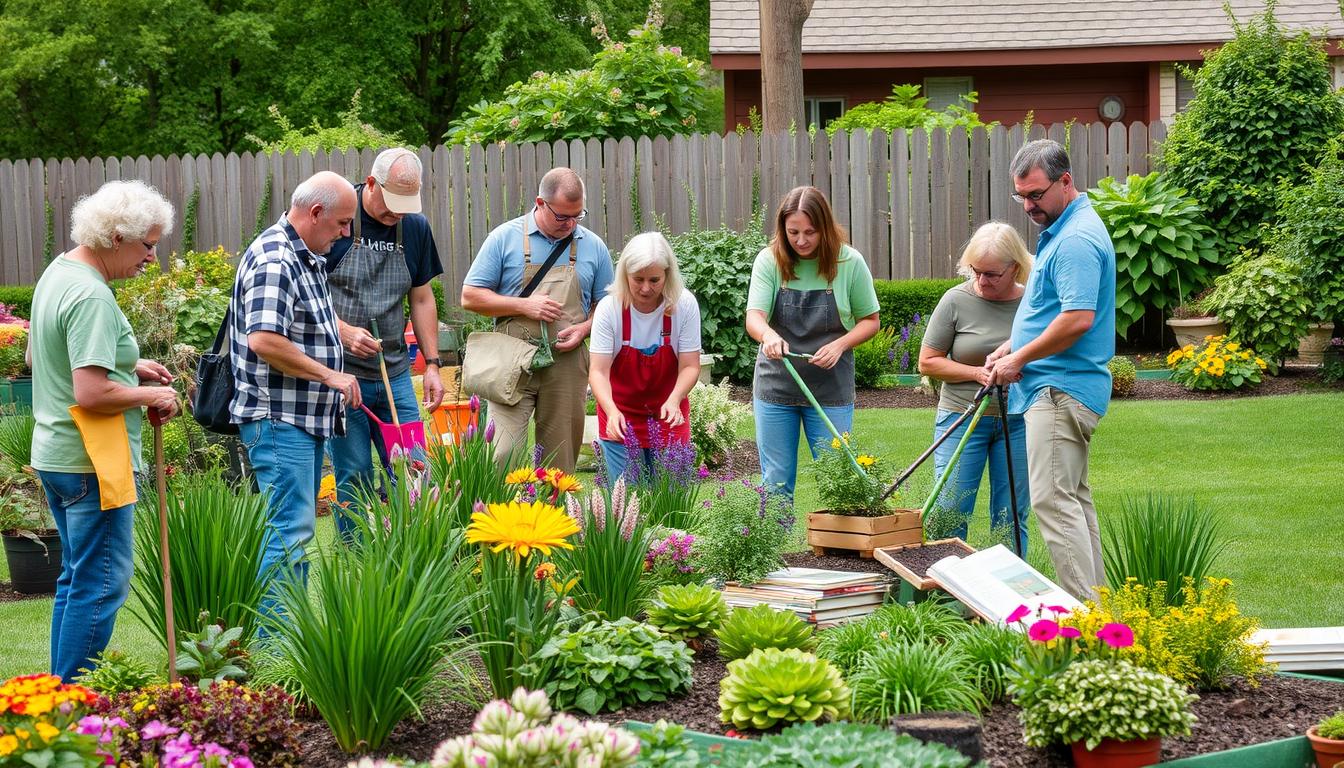
Did you know a well-kept lawn can boost a home’s value by up to 15%? Yet, many struggle to keep their yards looking great. That’s where community comes in. By starting a lawn care community, you can share knowledge, resources, and support. This helps everyone achieve beautiful grass and gardens.
Starting a lawn care community is rewarding for everyone involved. It brings together lawn lovers, creating a network for support and knowledge. This guide will show you how to build and grow a successful lawn care community in your area.
Key Takeaways
- Creating a lawn care community offers a support network and shared knowledge.
- Understanding your area’s needs is key to a thriving community.
- Use online platforms and in-person events to boost engagement.
- Provide educational resources and promote eco-friendly lawn care.
- Involve the community in service projects to build pride.
Understand the Importance of Community in Lawn Care
Keeping a lawn looking great takes a lot of time, effort, and special knowledge. Many homeowners find it hard to keep their lawns in top shape. By joining a community lawn care group, they can share the load and gain many benefits.
Benefits of a Lawn Care Community
A strong lawn care community lets homeowners swap tips and advice. It also helps find reliable local lawn services. Most importantly, it builds a sense of neighborhood pride in our green spaces.
Challenges Faced by Homeowners in Lawn Maintenance
Many homeowners want a beautiful lawn but face big challenges. Lawn care needs a lot of time, effort, and special knowledge. Finding good and affordable lawn care service providers can be hard, leaving many feeling lost.
“A study conducted by my local Lawn Care Association revealed that 78% of homeowners believe that having a well-manicured lawn improves the overall aesthetics of their neighborhood.” – Sam, author of this blog
| Benefit | Impact |
|---|---|
| Shared lawn care knowledge | Empowers homeowners to improve their skills |
| Access to local lawn services | Connects members with reliable providers |
| Sense of community responsibility | Fosters pride in the neighborhood’s green spaces |
Assess the Needs of Your Local Area
To build a successful lawn care community, you must first know your local area’s unique needs. Look at the residential and commercial green spaces in your area. This way, you can meet the specific challenges and preferences of your community.
Identify Residential and Commercial Green Spaces
Start by looking at the types of properties in your area. This includes single-family homes, multi-unit buildings, businesses, and public parks. Check the condition and maintenance needs of lawns, gardens, and landscaping. This helps you know who your lawn care community should serve and what local lawn care needs to address.
To get a full picture, use different methods. For example:
- Conduct interviews with community members
- Organize focus groups to talk about lawn care challenges
- Observe the community green spaces yourself
- Send out needs surveys to residential lawns and commercial landscaping owners
- Analyze existing data on the area
By finding out what your community needs, you can better understand your target audience. Then, you can tailor your lawn care community efforts to meet those needs.
| Data Source | Insights Gathered |
|---|---|
| Interviews | Perceived needs, expressed needs, and community strengths |
| Focus Groups | Specific problems and unmet needs shared by the community |
| Observations | Condition and maintenance of community green spaces |
| Needs Surveys | Normative, absolute, and relative needs of the community |
| Existing Data | Demographic characteristics and trends of the target audience |
“Understanding the specific needs and characteristics of your local area is essential for creating a lawn care community that truly resonates with the people it aims to serve.”
Establish a Platform for Lawn Care Community
To bring your local lawn care community together, you need a strong platform. This platform should make communication, sharing knowledge, and working together easy. You can do this by starting an online discussion forum or using social media groups that fit your community’s needs.
Create an Online Forum or Social Media Group
An online forum or social media group is like a virtual meeting place. Here, homeowners can connect, ask questions, and share lawn care tips and resources. These platforms help with virtual knowledge sharing. They also let you share important updates, announcements, and educational content with the group.
- Online forums have features like threads, polls, and user profiles for structured discussions.
- Social media groups, like those on Facebook or LinkedIn, are more casual and interactive.
- Make sure the platform you pick is easy to use and accessible to your audience.
Organize In-Person Meetings and Events
Having an online presence is key, but in-person events are also important. These events help build strong connections, offer hands-on learning, and provide networking opportunities for members.
- Plan educational workshops on lawn care, maintenance, and green practices.
- Host seasonal get-togethers for members to share experiences, ask questions, and bond.
- Work with local experts, like landscapers or horticulturists, to lead demonstrations and share their knowledge.
By combining online and offline elements, you can build a vibrant lawn care community. Here, homeowners can connect, learn, and grow together.
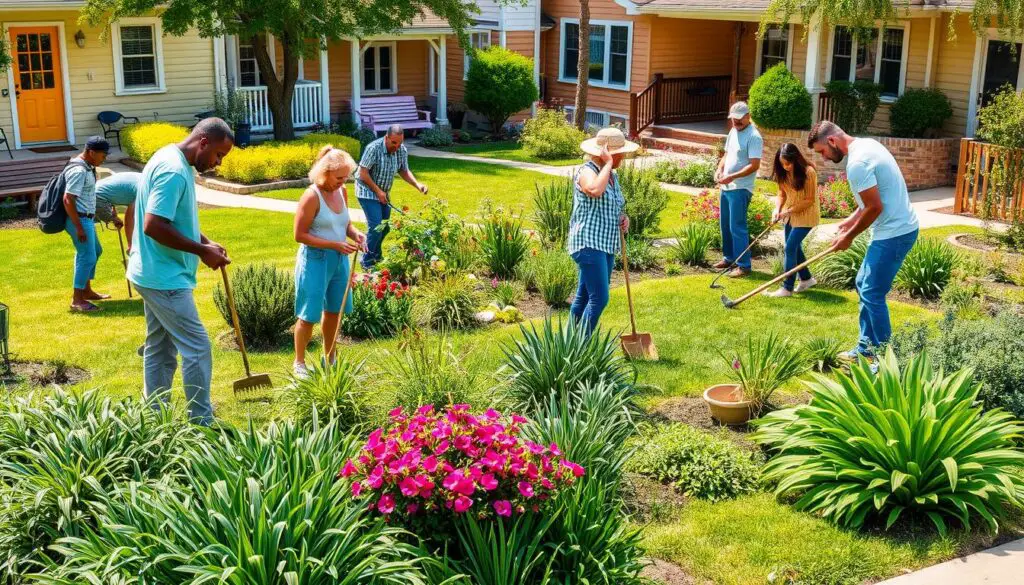
Recruit Members for the Lawn Care Community
Building a strong growing lawn care community begins with member recruitment. You need to spread the word about your online platform and events. Effective targeted outreach and community partnerships are crucial for growth.
Use your digital channels to show the value of your community. Share useful content and success stories. Make it simple for people to join. Talk to neighborhood groups and local agencies for partnerships.
Give members valuable resources and events. This builds a sense of community. Make sure members feel they can connect, learn, and contribute.
| Recruitment Strategies | Incentives and Benefits |
|---|---|
|
|
By recruiting and engaging members, you’ll create a vibrant community. It will be all about collaboration, sharing knowledge, and caring for lawns.
“The key to a successful lawn care community is creating a sense of belonging and shared purpose among its members. Attracting the right people and keeping them engaged is essential for long-term growth and impact.”
Develop a Knowledge-Sharing System
To make your lawn care community thrive, it’s key to share knowledge. By using local experts and encouraging members to share, you help everyone improve their outdoor spaces. This way, your community can grow stronger and greener.
Invite Experts to Share Lawn Care Tips
Invite local lawn care pros, horticulturists, and leaders to join your community. They can teach about lawn care, soil health, pest control, and green landscaping. Host workshops and Q&A sessions to give your members valuable expert-led educational content.
Encourage Members to Share Experiences and Advice
Also, let your community share their own stories and tips. Create spaces for updates, questions, and advice. This peer-to-peer knowledge exchange is priceless. Homeowners often find the best advice from those who’ve faced similar problems.
With a strong knowledge-sharing system, your community becomes a center for industry best practices and sustainable lawn care methods. It’s a place where members can learn from each other and make their green spaces better.
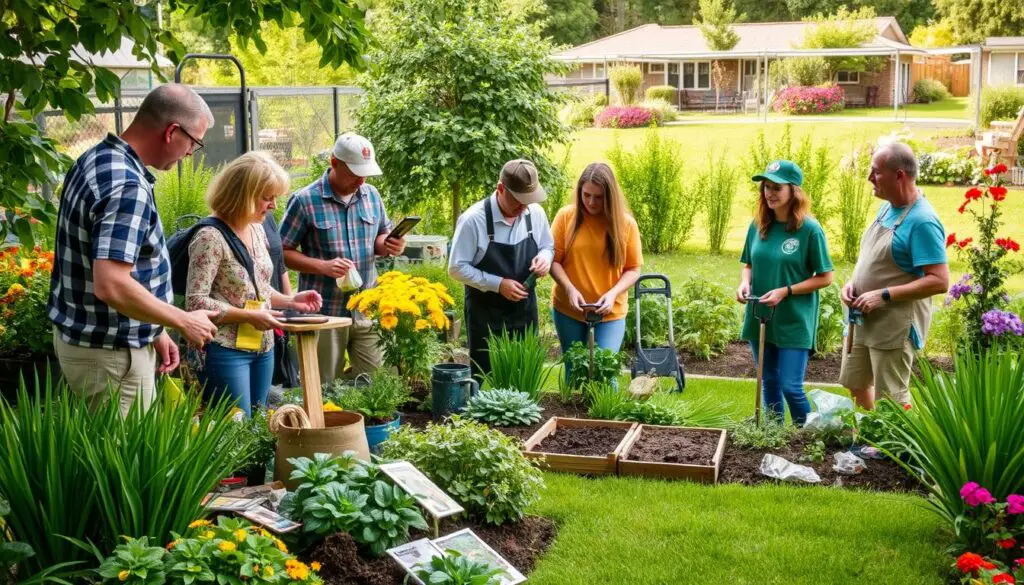
| Benefits of Knowledge Sharing in Lawn Care Communities | Challenges of Knowledge Sharing in Lawn Care Communities |
|---|---|
|
|
Foster Collaboration and Networking
A great lawn care community does more than just share tips. It also helps members work together and share resources. This way, they can solve problems and achieve more than alone.
Facilitate Connections Between Members
Help members team up for big lawn care tasks. Maybe one knows how to do a big landscaping job, and another has the right tools. This teamwork leads to collective problem-solving and shared resources.
Members can also work together on big issues like pests or fixing up green spaces. Lawn care community collaboration lets everyone use their strengths to find new solutions.
To boost member networking, plan meetups, workshops, or social events. These gatherings help members connect, share ideas, and build friendships. Such connections can lead to strong partnerships and a sense of unity.
“Collaboration is the key to unlocking innovation and growth. When we work together, we can achieve far more than we ever could alone.” – Shawn Johnson, Landscape Conservation Expert
Creating a culture of teamwork and networking makes your lawn care community stronger. It becomes a place where everyone shares knowledge, resources, and solves problems together. This leads to a more lively, involved, and strong community for all.
Offer Educational Resources and Training
To empower your lawn care community, it’s key to offer educational resources and hands-on training. Organize workshops and seminars led by industry experts. This way, you can give homeowners the practical lawn care education they need to care for their green spaces better.
Organize Workshops and Seminars
Invite local lawn care experts to share their knowledge. They can talk about proper mowing techniques, efficient soil preparation, and sustainable organic fertilization. They can also discuss integrated pest management (IPM) strategies. These hands-on workshops and industry expert-led training sessions will help community members gain the DIY lawn care skills they need.
For example, the Penn State Extension offers many educational resources. They have guides on turfgrass fertilization and late fall fertilizer applications for athletic fields. By using these resources and hosting hands-on workshops, you can help homeowners take better care of their local green spaces.
| Educational Resource | Key Takeaways |
|---|---|
| Integrated Pest Management (IPM) | An efficient and environmentally-friendly approach to managing pests in lawns and gardens. |
| Turfgrass Fertilization | Proper fertilization practices are crucial for improving and maintaining healthy turf. |
| Late Fall Fertilizer Applications | Optimal timing for fertilizing athletic fields and other high-traffic turf areas. |
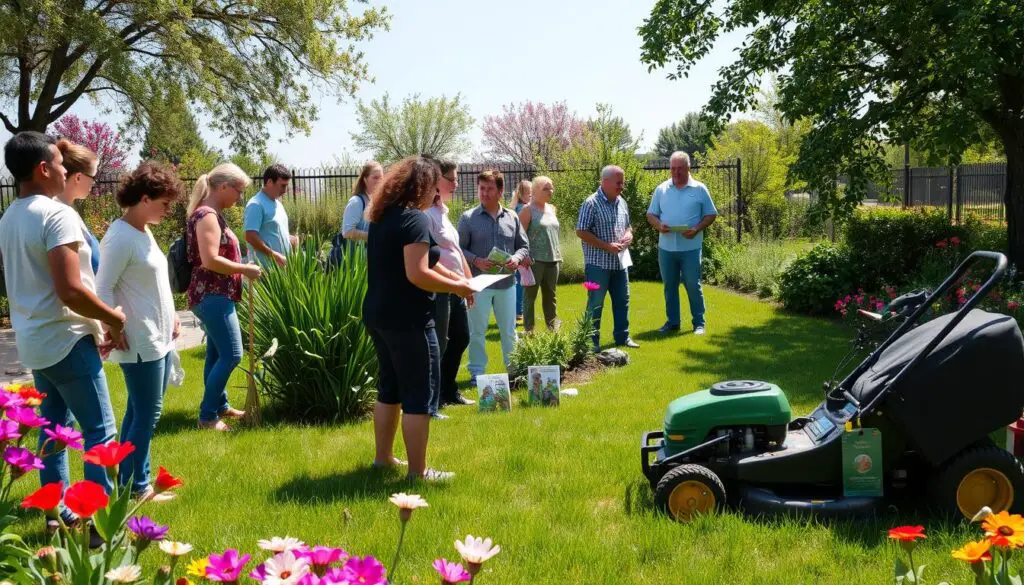
“Empowering homeowners with practical lawn care skills can transform the look and health of an entire neighborhood.” – Fin, follower of The Mowers Guide
Promote Sustainable Lawn Care Practices
Our lawn care community is growing fast. It’s key to focus on green and eco-friendly ways to care for our lawns. These methods help make our green spaces healthier and more resilient. They also lessen our impact on the environment.
Educate on Eco-Friendly Lawn Care Methods
First, let’s teach our members about the perks of using native plant species. These plants fit well in our local climate. They need less water, fertilizer, and upkeep than regular grass. This saves natural resources and helps local biodiversity by offering food and homes for native animals and pollinators.
We’ll also dive into water-saving irrigation methods. These methods cut down on the water we use for lawn care. By choosing drought-resistant plants and watering at the right times, we can use less water. This helps save water and supports conservation efforts.
Another important part of green lawn care is organic pest management. We’ll discover natural ways to fight pests and weeds. This includes encouraging good bugs, using organic fertilizers, and avoiding harmful chemicals. These steps protect our environment.
| Sustainable Lawn Care Practices | Benefits |
|---|---|
| Native plant selection | Less water, fertilizer, and upkeep needed; supports local wildlife |
| Water-wise irrigation | Uses less water; saves natural resources |
| Organic pest management | Natural pest control; avoids harmful chemicals |
By adopting these green lawn care practices, we can build a better community. Our homes and the environment will benefit. Together, we can show the strength of eco-friendly landscaping.
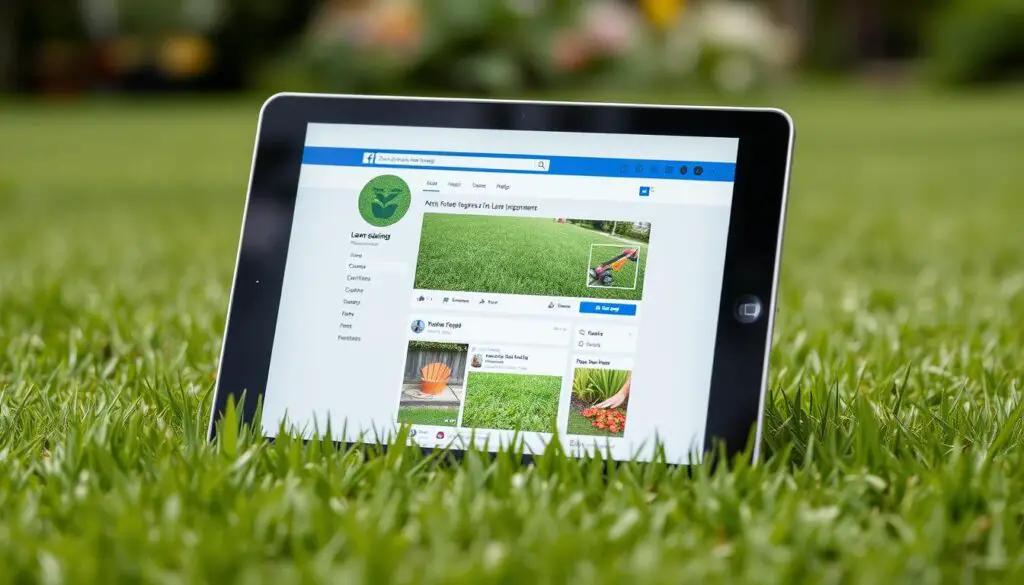
Encourage Community Involvement
We have a chance to share knowledge and resources in our lawn care community. We can also build a sense of community and pride. One way is by starting volunteer projects like neighborhood cleanups, garden plantings, or fixing up public green spaces.
These projects make our community look better and bring people together. They help us work as a team. This way, we can make our community stronger and more united.
Also, these projects can inspire others to care for their lawns and gardens. It’s a great way to make our neighborhood more beautiful and build a stronger community spirit.

